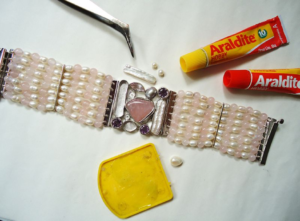Glues have been used in commercial and domestic setting for more than four thousand years. There are now hundreds of different types on the market.
Each of these varying types is often designed with a specific purpose in mind, such as wood or metal glue. Using the right type of glue the for the job at hand can make a big difference to how easy the task is, as well as how long the bond will last.
When it comes to jewellery making, consideration also needs to be given to the type of applicator that comes with a glue given that items are generally small and quite fiddly to handle. So let’s take a look at some things to consider when choosing a glue for jewellery making.
To Glue or Not to Glue
Firstly, it should be noted that many traditionalists in the jewellery industry believe that glue should not be used at all in the production of pieces, preferring to use the wiring method instead. However, others believe it would be difficult, if not impossible, to construct many pieces without the use of a bonding agent.
But remember that working with any type of adhesive can be dangerous if you don’t follow some basic safety rules or if they’re not used correctly. This site offers some advice about using glue safely and what to do if something does go wrong.
Considerations When Choosing a Glue for Jewellery Making
There are a number of factors that will determine the best glue for the job. Firstly, the types of materials you’re trying to join, whether that is gemstone to metal or metal to metal. If you require a specific metal bonding adhesive, try one supplied by http://www.ct1ltd.com/product-applications/metal-to-metal-adhesive/, a leading authority in the development of adhesives.
Next, think about the size and weight of the materials you’re using and how large the finished item will be. Cost, as with most things, might also be a factor. If you’re mass-producing cheap pieces that aren’t expected to last long, you might opt for a less effective but cheaper glue. The size and precision of the applicator are also important, depending on the intricacy of the piece.
As with any surface you’re attempting to bond, make sure it is clean and free from dirt, dust or grease before you start.
